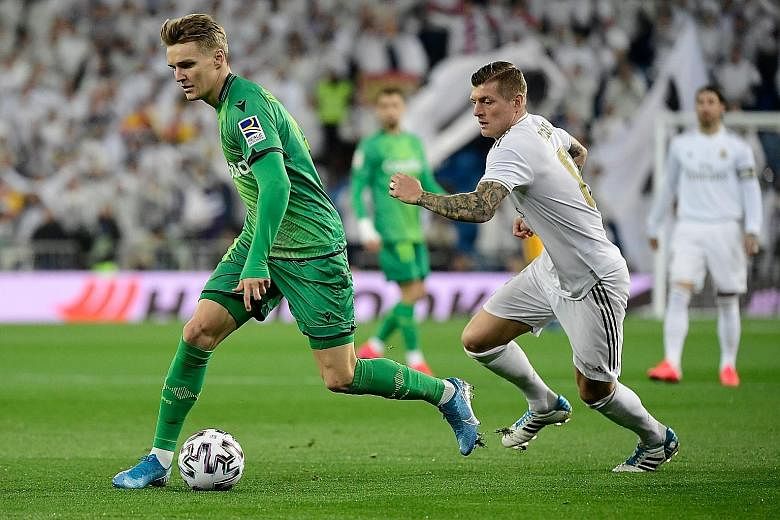Real Madrid and Barcelona are the clubs that are topmost on the mind whenever Spanish La Liga football is mentioned, but the league is progressively looking to change that.
Real Sociedad and Athletic Bilbao pulled off a Basque double in the King's Cup last week, knocking out 19-time winners Real and record 30-time champions Barca respectively to move into the final four of the competition.
Sociedad (eighth) and Bilbao (ninth) are also in the mix for a top-four spot this season. Along with unfancied Getafe, who are in third, and seventh-placed Villarreal, these teams are posing a big threat to the usual Champions League contenders like Valencia, Sevilla and Atletico Madrid.
Starting with the 2016-17 season, La Liga has redistributed its TV money more evenly in a bid to boost competitive balance, enabling mid-table and bottom-half teams to reinvest that income in their squads to shake up the established order. Before the collective sale, Real and Barcelona bagged more than 50 per cent of that revenue stream as they could negotiate their own TV rights.
In figures provided by the Spanish league for last season - the distribution of broadcasting income for this campaign has yet to be tabulated - current champions Barcelona (€166.5 million or S$253.3 million) and Real (€155.3 million) still received the lion's share from a total of €1.42 billion.
However, the amount that clubs like Bilbao (€74.8 million) and Sociedad (€59.1 million) are now getting is nothing to be sniffed at, giving them a massive leg-up in setting loftier goals.
They can now target places in Europe, rather than being preoccupied with maintaining their places in the top flight each year.
This was not the case in the past.
To get a sense of how skewed the financials were, in the 2013-14 season, then La Liga champions Atletico earned a paltry €42 million from TV rights, €32.5 million less than what Cardiff, who finished bottom of the English Premier League that campaign, brought home.
Barcelona and Real are still streets ahead of the Spanish chasing pack as the top two richest clubs in the world with €840.8 million and €757.3 million respectively, according to last month's Deloitte Football Money League.
But Sociedad's academy director, Luki Iriarte, believes the playing field is being levelled every year as they can invest larger sums at the grassroots level, which is the lifeblood of regional sides.
Speaking at Zubieta, the academy's training complex in San Sebastian, on Saturday, he said: "All the teams are now getting more money and of course, this is making La Liga more competitive and equal.
"Even though Real Madrid and Barcelona have a huge advantage, the rest of the teams are more or less equal in terms of what they are now getting."
-
23%
Percentage of TV revenue Real Madrid and Barcelona receive under the new collective sale package, a dip from the over 50 per cent previously.
Sociedad are reusing the funds to improve football in the province, with Iriarte adding: "The money is being used to enhance our system with its affiliated clubs together with the academy to improve the training and development of young players that have the potential to make it to the first team."
Former Sociedad player Xabi Prieto agreed that "it is a good thing" that the financial gulf between La Liga's "Big Two" and the rest of the league is no longer widening.
The greater balance has also been a godsend for a club like Eibar, who are the second-smallest team to ever feature in the top flight.
With space for only 8,164 fans, its Ipurua stadium is by far the smallest in the division, leaving them trailing in ticket sales revenue as compared to other top-flight Basque rivals, including Alaves, Bilbao and Sociedad.
But thanks to the influx of TV revenue (€50.8 million last season), chief executive officer Jon Ander Ulazia said on Thursday the team were able to stave off relegation since the 2014-15 season, when they were promoted for the first time.
Redevelopment work, which TV money paid for, has boosted Ipurua's capacity by 3,000 and Eibar now have a transfer budget of €10 million, an unthinkable sum before, given that Los Armeros have spent the majority of their history in the second and third tiers.
That is exactly the sort of impact that Joris Evers, the league's chief communications officer, feels is helping to make La Liga "the most competitive in the world".
He added: "It's enabling us to grow as a brand.
"We are the best league in the world and going forward, it will aid us in our aim to become the best, if not the second-most watched league in the world (behind the domestic football competition)."

